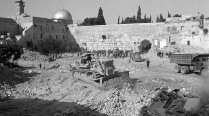The war marked the beginning of what Jubeh later described as his obsession with Israeli bulldozers: they changed landmarks, razed Arab homes, and obliterated familiar and beloved places, like the Moroccan Quarter. The bulldozers also laid waste to the Jordanian army watch post. Soon after returning to his home, Jubeh made his way to the site and found the bloated bodies of Jordanian soldiers, presumably those who had befriended him. The child covered them with dirt and tree branches and recited a prayer for them. Recalling the incident years later, he described their burial as being “in a manner not befitting those who had died defending Jerusalem.”3 Israel later bulldozed the site to create a parking lot, and so he could not even go to read them a prayer, a fact he recalled decades later with some sadness. In retrospect, he thought they had been killed by napalm bombs.
Walking to school after the war, Jubeh’s route took him past a plaza built on the ruins of the Moroccan Quarter. The school itself underwent changes; the Israeli government removed the Jordanian textbooks and imposed on the school the same curriculum as that taught to Palestinians living in the territories occupied by Israel in 1948. Palestinians opposed these changes and demanded a restoration of the Jordanian curriculum, which finally happened a few years later.
When he finished eighth grade in 1969, he decided to enroll in the Arab Kuwaiti College in Abu Dis. The decision was political: the structure was slated for confiscation by Israel, which reportedly wanted to turn it into a military camp. The local community worked quickly to prepare the building to receive students. Jubeh did not consult his parents before changing schools, however, as he believed that it was part of his patriotic duty and moved forward, doing what he thought was right. He was only 14 years old at the time.4
Two years later, he enrolled at the Hashemite school in al-Bira, which offered a scientific curriculum for the last two years of high school. Six months into grade 11, he was arrested. It was the first of many arrests for anti-occupation activities, and at 30 months, it was the longest.5

